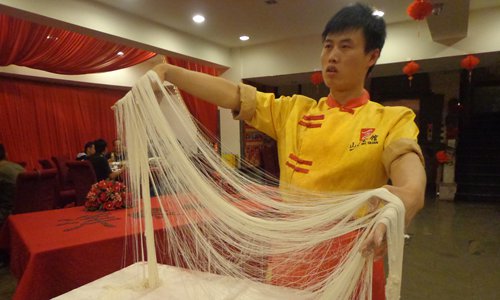
Shanxi hand-pulled noodles (Photo/GT)
A day in Datong
The next day, I was on my way to Datong, which was an important strategic military area where the provinces of Shanxi, Hebei and the Inner Mongolia Autonomous Region meet.
Shanxi saw its fortunes rise very early. During the Ming (1368-1644) and Qing (1644-1911) dynasties, trade merchants known as "Jin merchants" starting -bringing trade and commerce into the region.
Besides enjoying a good reputation domestically and even in Japan and -Russia, these merchants paved the way for the modern Chinese financial industry by establishing currency exchanges.
This history is depicted in art at various cultural heritage sites in Shanxi, such as the Yong'an Temple.
I was truly in awe when I realized that all the seamless financial transactions that take place today all started right where I was!
Visiting the Great Wall is on everyone's list. Well, Shanxi has a part (and a mighty well-preserved part) of the Great Wall as well.
There are nine major passes around the country and Yanmenguan, or Yanmen Pass, lies in Shanxi, so I decided to head there.
There was a Chinese opera performance taking place in one of the interior buildings of the more than five--kilometer-long section of the wall and the dramatic notes of the music just added to the majestic aura of the Great Wall.
Moving on from the Great Wall, the Leaning Tower of Pisa and the Eiffel Tower in Paris are also well-known wonders of the world.
Along with these world-famous towers, the Yingxian Pagoda in Shuozhou city, Shanxi, is the world's third great tower.
At about 67.3 meters high, it is the highest and oldest wooden pagoda in China. It is also known as the Sakyamuni Pagoda of Fogong Temple.
It was built in the Khitan-led Liao -Dynasty (916-1125) in 1056 without using a single nail.
Over the past 960 years, it has acquired a slight tilt and thus the topmost sections are inaccessible to the general public.
The octagonal tower though stands firm and the wooden bells on the eaves bring soul-soothing chimes to your ears as the bells create a melodious harmony with the gentle breeze wafting in the air.
Heritage from the dynasties
The Nine Dragon Screen in Datong is another major tourist attraction. It was built for the 13th son of the first emperor of the Ming Dynasty.
It depicts nine dragons using their ability to control rainfall and call the wind - one dragon is even shown wrestling the sea!
Moving from the ferocity of the -dragons, I next went into the peaceful atmosphere -offered by the Yungang Grottoes located along the Shili River at the base of Wuzhi Mountain.
These ancient grottoes are a masterpiece of Buddhist architecture encompassing more than 5,100 Buddha statues standing in a multitude of positions in its 51 main grottoes.
Built during the Northern Wei -Dynasty (386-534), some of the grottoes are so precious that even photography isn't allowed inside in order to preserve the facades from glare of bright light.
The largest of the grottoes is cave No.6 which has 33 embossed panels featuring vivid depictions of the story of the Buddha.
The Yungang grottoes are listed as a UNESCO World Heritage site.
If you would like to see a beautiful culmination of traditional Chinese art with Indian Gandhara Buddhist art, blended with social depictions of the era, the Yungang Grottoes are a not-to-miss site in Shanxi.
Magnificent Mount Hengshan
Although Shanxi has a lot of temples, like the Confucious Temple, Yong'an Temple and the Water Goddess Temple, the Hanging Temple on Mount Hengshan, located in the Jinlong valley, tops my list.
The Hanging Temple gets its name because it literally "hangs" off the west cliff of the mountain.
Supported by cross beam stilts inserted in the rock, the support for the architectural marvel is provided solely by cliff face.
Built in 491, surviving more than 1,500 years of wind and weather has been no mean feat. The Hanging Temple is truly the epitome of Chinese cultural achievement.
The waterfall and the gurgling of the waters below the monastery made me want to stay there forever, cradled by nature.
I wanted to take a souvenir home from Shanxi of course, so a visit to the Guangling Paper-cutting Factory presented me with the perfect opportunity to fulfill that goal.
With paper as its medium, the intangible heritage of China can be seen here in the painstakingly precise art of paper-cutting, wherein delicate yet awe-inspiring products are created by mere human hands and keen human eyes.
I absolutely had to bring one home, so I purchased one right then and there without a thought.
Guangling paper-cutting was an -interesting and incredible testimony to the intangible cultural heritage of Shanxi.
The sheer amount of tangible and intangible cultural heritage in Shanxi makes the province a living breathing museum of ancient Chinese architecture that allows you to breathe in the glorious past.
Rules of thumb:
1. If you are in Shanghai or Beijing, you can fly directly to Taiyuan. All major airlines fly to Taiyuan and the flight takes only about 2.5 hours from Shanghai and 1.5 hours from Beijing.
2. You can also opt for the high speed rail. Taiyuan is connected to all major cities in China by the high speed bullet train. Depending on the train and city you start from, it may take 2.5-11 hours to reach Taiyuan.
3. If you want to go to Datong, you can easily get a direct flight. Or from Taiyuan, it only takes 3 hours by bus to reach the city.
4. Due to Shanxi's varied climate, the difference between day and night temperatures is significant. Remember to take along warm woollen clothing to tackle the dipping temperatures at night, especially in Datong.


















































